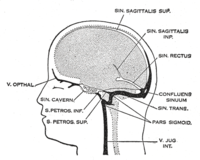
Photo from wikipedia
Cerebral venous thrombosis (CVT) is a rare type of stroke that may cause an intracranial hypertension syndrome as well as focal neurological deficits due to venous infarcts. MRI with venography… Click to show full abstract
Cerebral venous thrombosis (CVT) is a rare type of stroke that may cause an intracranial hypertension syndrome as well as focal neurological deficits due to venous infarcts. MRI with venography is the method of choice for diagnosis, and treatment with anticoagulants should be promptly started. CVT incidence has increased in COVID-19-infected patients due to a hypercoagulability state and endothelial inflammation. CVT following COVID-19 vaccination could be related to vaccine-induced immune thrombotic thrombocytopenia (VITT), a rare but severe complication that should be promptly identified because of its high mortality rate. Platelet count, D-dimer and PF4 antibodies should be dosed. Treatment with non-heparin anticoagulants and immunoglobulin could improve recuperation. Development of headache associated with seizures, impaired consciousness or focal signs should raise immediate suspicion of CVT. In patients who received a COVID-19 adenovirus-vector vaccine presenting thromboembolic events, VITT should be suspected and rapidly treated. Nevertheless, vaccination benefits clearly outweigh risks and should be continued.
Journal Title: Life
Year Published: 2022
Link to full text (if available)
Share on Social Media: Sign Up to like & get
recommendations!